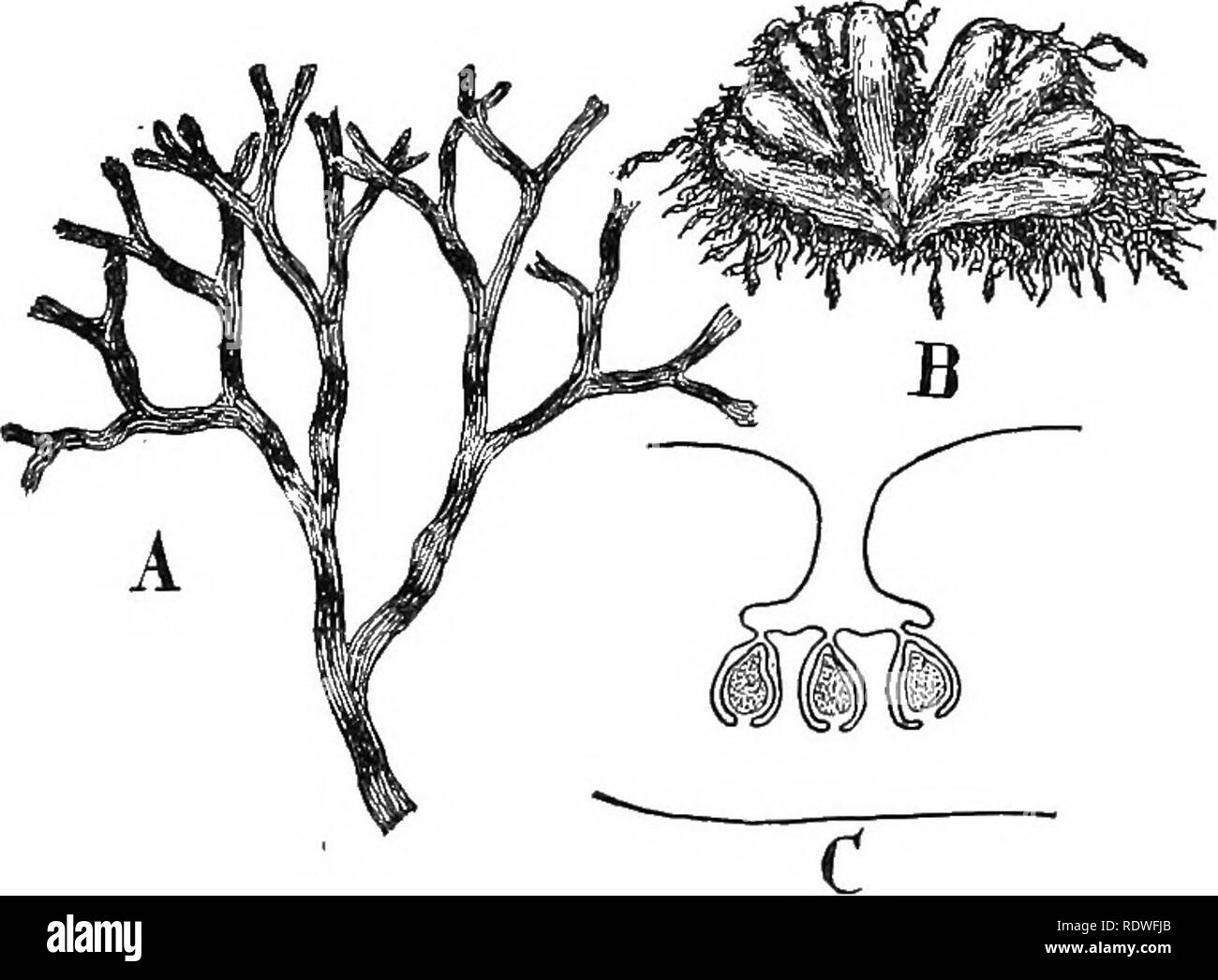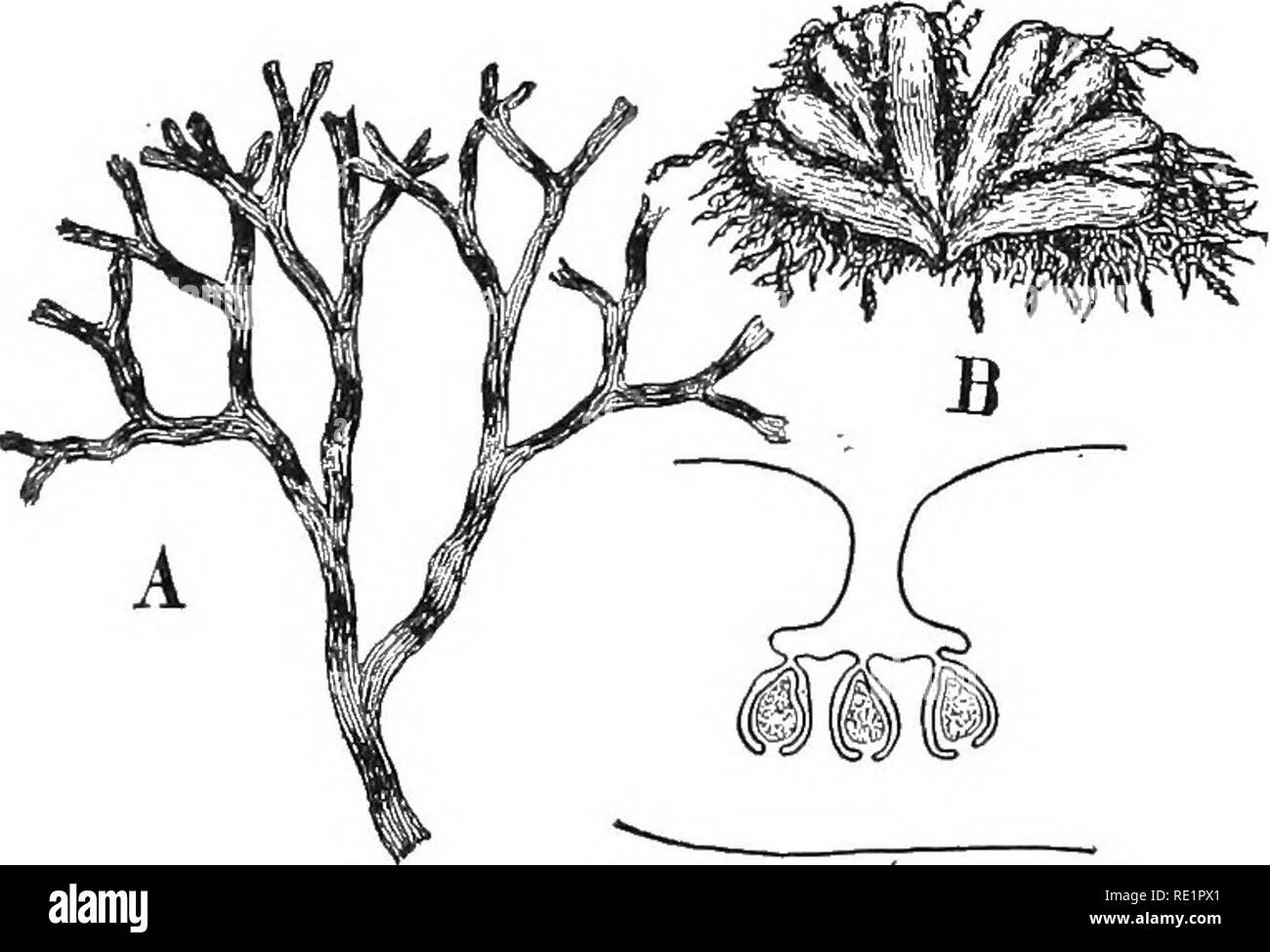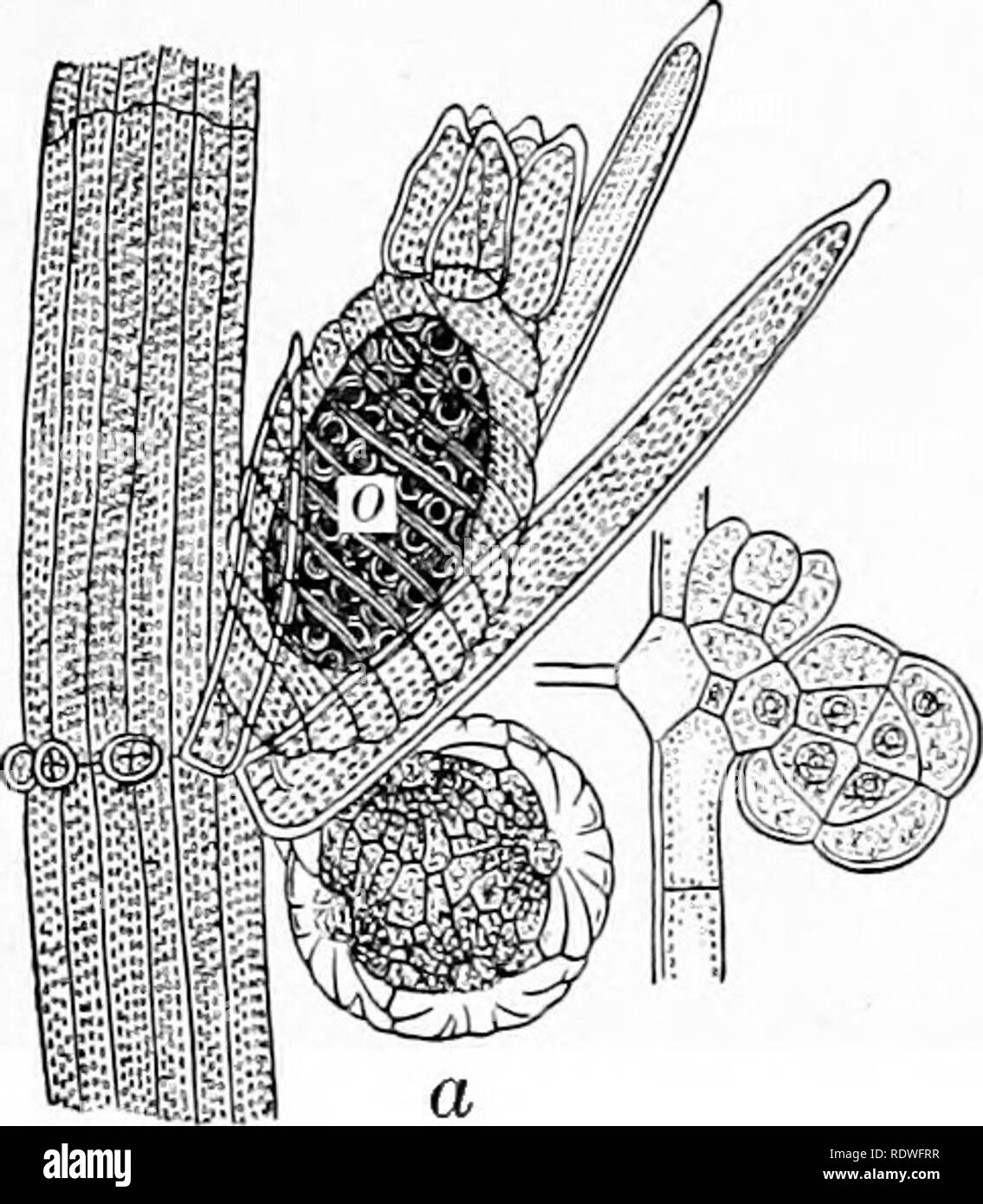Terrestrial algae Black & White Stock Photos
 . Nature and development of plants. Botany. 272 STRUCTURE OF RICCIOCARPUS or dichotomous branching of the thallus, so characteristic of these plants (Fig. 179, A, B). The appearance of many of these hepatics is suggestive of the algae. Especially is this true of the aquatic Ricciocarpus and Riccia. (a) Structure of Ricciocarpus.—^An examination of the struc- ture of one of these will show, however, that extensive changes have been induced in even the simplest forms. The new stimuli to which the terrestrial conditions expose them cause a remark- able series of transformations in the cells that Stock Photohttps://www.alamy.com/image-license-details/?v=1https://www.alamy.com/nature-and-development-of-plants-botany-272-structure-of-ricciocarpus-or-dichotomous-branching-of-the-thallus-so-characteristic-of-these-plants-fig-179-a-b-the-appearance-of-many-of-these-hepatics-is-suggestive-of-the-algae-especially-is-this-true-of-the-aquatic-ricciocarpus-and-riccia-a-structure-of-ricciocarpusan-examination-of-the-struc-ture-of-one-of-these-will-show-however-that-extensive-changes-have-been-induced-in-even-the-simplest-forms-the-new-stimuli-to-which-the-terrestrial-conditions-expose-them-cause-a-remark-able-series-of-transformations-in-the-cells-that-image232286387.html
. Nature and development of plants. Botany. 272 STRUCTURE OF RICCIOCARPUS or dichotomous branching of the thallus, so characteristic of these plants (Fig. 179, A, B). The appearance of many of these hepatics is suggestive of the algae. Especially is this true of the aquatic Ricciocarpus and Riccia. (a) Structure of Ricciocarpus.—^An examination of the struc- ture of one of these will show, however, that extensive changes have been induced in even the simplest forms. The new stimuli to which the terrestrial conditions expose them cause a remark- able series of transformations in the cells that Stock Photohttps://www.alamy.com/image-license-details/?v=1https://www.alamy.com/nature-and-development-of-plants-botany-272-structure-of-ricciocarpus-or-dichotomous-branching-of-the-thallus-so-characteristic-of-these-plants-fig-179-a-b-the-appearance-of-many-of-these-hepatics-is-suggestive-of-the-algae-especially-is-this-true-of-the-aquatic-ricciocarpus-and-riccia-a-structure-of-ricciocarpusan-examination-of-the-struc-ture-of-one-of-these-will-show-however-that-extensive-changes-have-been-induced-in-even-the-simplest-forms-the-new-stimuli-to-which-the-terrestrial-conditions-expose-them-cause-a-remark-able-series-of-transformations-in-the-cells-that-image232286387.htmlRMRDWFJB–. Nature and development of plants. Botany. 272 STRUCTURE OF RICCIOCARPUS or dichotomous branching of the thallus, so characteristic of these plants (Fig. 179, A, B). The appearance of many of these hepatics is suggestive of the algae. Especially is this true of the aquatic Ricciocarpus and Riccia. (a) Structure of Ricciocarpus.—^An examination of the struc- ture of one of these will show, however, that extensive changes have been induced in even the simplest forms. The new stimuli to which the terrestrial conditions expose them cause a remark- able series of transformations in the cells that
 . Nature and development of plants. Botany. 272 STRUCTURE OF RICCIOCARPUS or dichotomous branching of the thallus, so characteristic of these plants (Fig. 179, A, B). The appearance of many of these hepatics is suggestive of the algae. Especially is this true of the aquatic Ricciocarpus and Riccia. (a) Structure of Ricciocarpus.—^An examination of the struc- ture of one of these will show, however, that extensive changes have been induced in even the simplest forms. The new stimuli to which the terrestrial conditions expose them cause a remark- able series of transformations in the cells that Stock Photohttps://www.alamy.com/image-license-details/?v=1https://www.alamy.com/nature-and-development-of-plants-botany-272-structure-of-ricciocarpus-or-dichotomous-branching-of-the-thallus-so-characteristic-of-these-plants-fig-179-a-b-the-appearance-of-many-of-these-hepatics-is-suggestive-of-the-algae-especially-is-this-true-of-the-aquatic-ricciocarpus-and-riccia-a-structure-of-ricciocarpusan-examination-of-the-struc-ture-of-one-of-these-will-show-however-that-extensive-changes-have-been-induced-in-even-the-simplest-forms-the-new-stimuli-to-which-the-terrestrial-conditions-expose-them-cause-a-remark-able-series-of-transformations-in-the-cells-that-image232379897.html
. Nature and development of plants. Botany. 272 STRUCTURE OF RICCIOCARPUS or dichotomous branching of the thallus, so characteristic of these plants (Fig. 179, A, B). The appearance of many of these hepatics is suggestive of the algae. Especially is this true of the aquatic Ricciocarpus and Riccia. (a) Structure of Ricciocarpus.—^An examination of the struc- ture of one of these will show, however, that extensive changes have been induced in even the simplest forms. The new stimuli to which the terrestrial conditions expose them cause a remark- able series of transformations in the cells that Stock Photohttps://www.alamy.com/image-license-details/?v=1https://www.alamy.com/nature-and-development-of-plants-botany-272-structure-of-ricciocarpus-or-dichotomous-branching-of-the-thallus-so-characteristic-of-these-plants-fig-179-a-b-the-appearance-of-many-of-these-hepatics-is-suggestive-of-the-algae-especially-is-this-true-of-the-aquatic-ricciocarpus-and-riccia-a-structure-of-ricciocarpusan-examination-of-the-struc-ture-of-one-of-these-will-show-however-that-extensive-changes-have-been-induced-in-even-the-simplest-forms-the-new-stimuli-to-which-the-terrestrial-conditions-expose-them-cause-a-remark-able-series-of-transformations-in-the-cells-that-image232379897.htmlRMRE1PX1–. Nature and development of plants. Botany. 272 STRUCTURE OF RICCIOCARPUS or dichotomous branching of the thallus, so characteristic of these plants (Fig. 179, A, B). The appearance of many of these hepatics is suggestive of the algae. Especially is this true of the aquatic Ricciocarpus and Riccia. (a) Structure of Ricciocarpus.—^An examination of the struc- ture of one of these will show, however, that extensive changes have been induced in even the simplest forms. The new stimuli to which the terrestrial conditions expose them cause a remark- able series of transformations in the cells that
 . An introduction to the study of seaweeds. Algae. CHLOROPHYCE^ 123 The Thallus.—There is hardly any type of habit assumed by the higher terrestrial plants that does not find itself represented in this singular genus. There are species named from their resemblance to mosses, club-mosses, cacti, yews, etc., etc., while others are of extremely simple form. This differentiation is not con- fined to the green assimilating shoot, but extends to the root- system with its creeping rhi- zome-like extensions. The plants frequently attain con- siderable stature, and are in most cases of remarkable beaut Stock Photohttps://www.alamy.com/image-license-details/?v=1https://www.alamy.com/an-introduction-to-the-study-of-seaweeds-algae-chlorophyce-123-the-thallusthere-is-hardly-any-type-of-habit-assumed-by-the-higher-terrestrial-plants-that-does-not-find-itself-represented-in-this-singular-genus-there-are-species-named-from-their-resemblance-to-mosses-club-mosses-cacti-yews-etc-etc-while-others-are-of-extremely-simple-form-this-differentiation-is-not-con-fined-to-the-green-assimilating-shoot-but-extends-to-the-root-system-with-its-creeping-rhi-zome-like-extensions-the-plants-frequently-attain-con-siderable-stature-and-are-in-most-cases-of-remarkable-beaut-image232313282.html
. An introduction to the study of seaweeds. Algae. CHLOROPHYCE^ 123 The Thallus.—There is hardly any type of habit assumed by the higher terrestrial plants that does not find itself represented in this singular genus. There are species named from their resemblance to mosses, club-mosses, cacti, yews, etc., etc., while others are of extremely simple form. This differentiation is not con- fined to the green assimilating shoot, but extends to the root- system with its creeping rhi- zome-like extensions. The plants frequently attain con- siderable stature, and are in most cases of remarkable beaut Stock Photohttps://www.alamy.com/image-license-details/?v=1https://www.alamy.com/an-introduction-to-the-study-of-seaweeds-algae-chlorophyce-123-the-thallusthere-is-hardly-any-type-of-habit-assumed-by-the-higher-terrestrial-plants-that-does-not-find-itself-represented-in-this-singular-genus-there-are-species-named-from-their-resemblance-to-mosses-club-mosses-cacti-yews-etc-etc-while-others-are-of-extremely-simple-form-this-differentiation-is-not-con-fined-to-the-green-assimilating-shoot-but-extends-to-the-root-system-with-its-creeping-rhi-zome-like-extensions-the-plants-frequently-attain-con-siderable-stature-and-are-in-most-cases-of-remarkable-beaut-image232313282.htmlRMRDXNXX–. An introduction to the study of seaweeds. Algae. CHLOROPHYCE^ 123 The Thallus.—There is hardly any type of habit assumed by the higher terrestrial plants that does not find itself represented in this singular genus. There are species named from their resemblance to mosses, club-mosses, cacti, yews, etc., etc., while others are of extremely simple form. This differentiation is not con- fined to the green assimilating shoot, but extends to the root- system with its creeping rhi- zome-like extensions. The plants frequently attain con- siderable stature, and are in most cases of remarkable beaut
 . Essentials of botany. Botany; Botany. Fig. 158. End of a Main Shoot of a Stonewort, Chara, (About natural size.) Fig. 159. Part of a "Leaf" of Fig. 158. (Considerably magniiied.) a, antheridium; u, oogonium. At the right are a young antheridium and archegonium. This plant is a familiar object, waving as it does from rocks, piles, and wharves alongshore. Terrestrial genera and species of green algae are not uncommon.. Please note that these images are extracted from scanned page images that may have been digitally enhanced for readability - coloration and appearance of these illustr Stock Photohttps://www.alamy.com/image-license-details/?v=1https://www.alamy.com/essentials-of-botany-botany-botany-fig-158-end-of-a-main-shoot-of-a-stonewort-chara-about-natural-size-fig-159-part-of-a-quotleafquot-of-fig-158-considerably-magniiied-a-antheridium-u-oogonium-at-the-right-are-a-young-antheridium-and-archegonium-this-plant-is-a-familiar-object-waving-as-it-does-from-rocks-piles-and-wharves-alongshore-terrestrial-genera-and-species-of-green-algae-are-not-uncommon-please-note-that-these-images-are-extracted-from-scanned-page-images-that-may-have-been-digitally-enhanced-for-readability-coloration-and-appearance-of-these-illustr-image232286539.html
. Essentials of botany. Botany; Botany. Fig. 158. End of a Main Shoot of a Stonewort, Chara, (About natural size.) Fig. 159. Part of a "Leaf" of Fig. 158. (Considerably magniiied.) a, antheridium; u, oogonium. At the right are a young antheridium and archegonium. This plant is a familiar object, waving as it does from rocks, piles, and wharves alongshore. Terrestrial genera and species of green algae are not uncommon.. Please note that these images are extracted from scanned page images that may have been digitally enhanced for readability - coloration and appearance of these illustr Stock Photohttps://www.alamy.com/image-license-details/?v=1https://www.alamy.com/essentials-of-botany-botany-botany-fig-158-end-of-a-main-shoot-of-a-stonewort-chara-about-natural-size-fig-159-part-of-a-quotleafquot-of-fig-158-considerably-magniiied-a-antheridium-u-oogonium-at-the-right-are-a-young-antheridium-and-archegonium-this-plant-is-a-familiar-object-waving-as-it-does-from-rocks-piles-and-wharves-alongshore-terrestrial-genera-and-species-of-green-algae-are-not-uncommon-please-note-that-these-images-are-extracted-from-scanned-page-images-that-may-have-been-digitally-enhanced-for-readability-coloration-and-appearance-of-these-illustr-image232286539.htmlRMRDWFRR–. Essentials of botany. Botany; Botany. Fig. 158. End of a Main Shoot of a Stonewort, Chara, (About natural size.) Fig. 159. Part of a "Leaf" of Fig. 158. (Considerably magniiied.) a, antheridium; u, oogonium. At the right are a young antheridium and archegonium. This plant is a familiar object, waving as it does from rocks, piles, and wharves alongshore. Terrestrial genera and species of green algae are not uncommon.. Please note that these images are extracted from scanned page images that may have been digitally enhanced for readability - coloration and appearance of these illustr